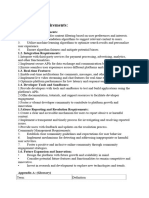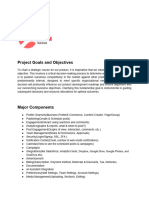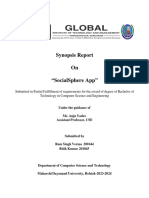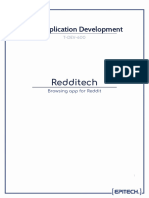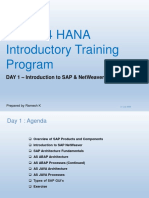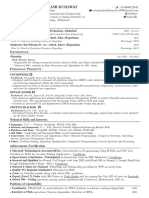PostPulseAI — UI/UX Designer Workflow
This workflow outlines all key tasks and considerations for the UI/UX design team building
PostPulseAI.
1. PostPulse AI — Technical Specification & Implementation Guide
2. PostPulse AI is a micro-SaaS product built for social media marketers that combines
analytics, AI content generation,
and multi-platform scheduling. The system predicts best posting times, auto-generates
captions and hashtags, performs
A/B tests, and automates publishing with a one-click workflow. This document provides a
developer-friendly,
implementable specification including frontend components, backend services, database
schema, APIs, background jobs,
integrations, security, deployment, and an MVP timeline.
3. Recommended stack: Next.js (React) + Tailwind CSS + Shadcn/UI for components. Deploy
on Vercel for CDN/Edge. Routing &
Pages: - / (Landing page) — marketing site + pricing. - /app/dashboard — main analytics +
calendar. - /app/accounts —
list of connected social accounts. - /app/create — post editor & asset uploader. -
/app/schedule — content calendar and
scheduled posts list. - /app/analytics — detailed reports & competitor heatmap. -
/app/settings — organization, team,
billing, brand voice. - /admin — internal admin for support and moderation (restricted).
Key Components: - AuthWrapper
(handles session & role-based UI). - PostEditor (WYSIWYG-style with media preview, variant
generator panel). -
VariantList (shows AI-generated captions & metrics predictions). - CalendarView
(drag/drop scheduling for posts). -
AnalyticsCharts (line charts, bar charts — use recharts; don't set default colors unless
requested). -
ConnectAccountModal (OAuth flow helper + permission checks). State Management: -
Lightweight global state with Zustand
for auth/session and small shared states. - Fetch data via React Query (TanStack Query) for
caching, retries, and
background refetch. Accessibility & Responsiveness: - Mobile-first design; ensure editor
supports uploads from mobile
devices. - Keyboard-accessible modals and aria labels for controls.
�4. users: - id UUID PK - name TEXT - email TEXT UNIQUE - password_hash TEXT - role TEXT
(enum: admin, member) - created_at
TIMESTAMP - updated_at TIMESTAMP
5. organizations: - id UUID PK - name TEXT - billing_customer_id TEXT - created_at
TIMESTAMP
6. memberships: - id UUID PK - user_id UUID FK - organization_id UUID FK - role TEXT
7. social_accounts: - id UUID PK - organization_id UUID FK - platform TEXT (enum:
instagram, facebook, linkedin, tiktok, x)
- platform_handle TEXT - platform_account_id TEXT - access_token TEXT (ENCRYPT at rest)
- refresh_token TEXT -
token_expires_at TIMESTAMP - permissions JSONB - meta JSONB
8. posts: - id UUID PK - organization_id UUID FK - author_id UUID FK - status TEXT (draft,
scheduled, publishing,
published, failed) - scheduled_at TIMESTAMP WITH TIME ZONE - posted_at TIMESTAMP -
platforms JSONB (list of
social_accounts + metadata) - attachments JSONB (S3 URLs, thumbnails) - created_at
TIMESTAMP
9. post_variants: - id UUID PK - post_id UUID FK - caption TEXT - hashtags TEXT[] -
media_overrides JSONB - ai_metadata
JSONB (prompt, model, tokens) - predicted_score FLOAT - created_at TIMESTAMP
10. schedules: - id UUID PK - post_id UUID FK - scheduled_at TIMESTAMP WITH TIME ZONE
- timezone TEXT - recurrence JSONB
(optional)
11. ab_tests: - id UUID PK - post_id UUID FK - variant_ids UUID[] - sample_size INT -
start_time TIMESTAMP - end_time
TIMESTAMP - winner_variant_id UUID
12. analytics_events (normalized): - id UUID PK - post_id UUID FK - platform TEXT -
impressions INT - engagements INT -
likes INT - shares INT - comments INT - fetched_at TIMESTAMP - raw_json JSONB
13. Request (POST /api/v1/ai/generate-caption): { "media_url": "https://s3.../video.mp4",
"brand_voice":
"friendly_informative", "tone": "excited", "length": "short" } Response: [
{"variant_id":"uuid","caption":"Short
punchy hook...","hashtags":["#growth"],"predicted_score":0.82}, {...} ]
14. OpenAI (or equivalent) is used as the primary generator. Key patterns: - Prompt
templates: Use brand voice profile and
example captions to prime model. - Safety & moderation: Send generated captions through a
�content moderation check. -
Caching: Cache caption responses for identical media_url + brand_voice inputs for N minutes
to limit token usage and
costs. - Rate-limiting: Use token bucket algorithm per-organization to prevent runaway
costs. Example prompt skeleton:
You are a creative social media copywriter for {brand_name}. The brand voice is
{brand_voice}. Create 3 short caption
variants for this media (link: {media_url}). Keep captions under 140 characters and include
2–4 relevant hashtags. Avoid
profanity. Provide a short rationale for each caption.
15. Platforms to integrate: - Meta Graph API (Instagram/Facebook Pages): Requires app
review for posting and read-insights.
Use long-lived tokens where available. - LinkedIn Marketing API: Company pages posting;
needs application review for
write access. - TikTok for Developers: varies by region and app permissions. - X (Twitter)
API: posting and metrics
access. Important: Each platform has changing policies and rate limits. Implement adapter
layers per platform to
encapsulate and centralize platform-specific logic and error handling. Always verify the
latest API docs before
production release.
16. Suggested stack: - Frontend: Vercel (Next.js), utilize edge functions for auth cookies and
personalization. - Backend:
Render / Railway / Fly.io for Node.js service; Dockerized deployments. - Database: Postgres
(managed, e.g., AWS RDS /
Supabase / PlanetScale alternative). - Cache & Queues: Redis (managed) for BullMQ. -
Storage: AWS S3 for assets; signed
URLs for uploads. CI/CD: - GitHub Actions pipeline: lint -> unit tests -> build -> deployment
(protected branches for
main/staging). - Migrations: Prisma migrations or Flyway for DB schema changes.
Monitoring & Observability: - Sentry
for error tracking. - PostHog or Amplitude for product analytics and funnels. - Logs:
centralized structured logs (e.g.,
Grafana Loki, Papertrail).
17. Week 0–2 (Discovery & Design): Specs, wireframes, API contracts, initial infra setup.
Week 3–6 (Core Backend + Auth +
DB): Implement auth, organizations, social account adapter skeleton, and Postgres schema.
Week 7–9 (Frontend MVP): Post
editor, account connect flow, basic dashboard, calendar view. Week 10–12 (AI, Scheduler &
Publish Worker): Integrate
OpenAI for caption generation, implement scheduler & publisher workers, add Stripe billing.
�Week 13–14 (Beta &
Hardening): Closed beta, bug fixes, monitoring, and documentation. Target: Public beta end
of Day 60.
18. CREATE TABLE users (id UUID PRIMARY KEY DEFAULT gen_random_uuid(), name TEXT,
email TEXT UNIQUE, password_hash TEXT,
role TEXT, created_at TIMESTAMP DEFAULT now()); CREATE TABLE organizations (id UUID
PRIMARY KEY DEFAULT
gen_random_uuid(), name TEXT, billing_customer_id TEXT, created_at TIMESTAMP DEFAULT
now()); CREATE TABLE
social_accounts (id UUID PRIMARY KEY DEFAULT gen_random_uuid(), organization_id UUID
REFERENCES organizations(id),
platform TEXT, platform_account_id TEXT, access_token TEXT, refresh_token TEXT,
token_expires_at TIMESTAMP, meta JSONB,
created_at TIMESTAMP DEFAULT now()); CREATE TABLE posts (id UUID PRIMARY KEY
DEFAULT gen_random_uuid(), organization_id
UUID REFERENCES organizations(id), author_id UUID, status TEXT, scheduled_at
TIMESTAMPTZ, posted_at TIMESTAMPTZ,
platforms JSONB, attachments JSONB, created_at TIMESTAMP DEFAULT now());



